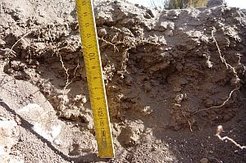Soil will absorb less carbon this century
By adding highly accurate radiocarbon dating of soil to standard Earth system models, environmental scientists from the University of California, Irvine (UCI) and other institutions have learned a dirty little secret: the ground will absorb far less atmospheric carbon dioxide this century than previously thought. Their research provides the impetus for adding to the global number of radiocarbon measurements to further improve understanding of the processes and timescales of carbon stabilization in soils.

Through photosynthesis, plants absorb CO2 from the air. When trees and vegetation die and decay, they become part of the soil, effectively locking carbon on or beneath the Earth’s surface instead of in the atmosphere where it contributes to global warming. In their study, the researchers show that since this process unfolds over millennia versus tens or hundreds of years, we should expect less land carbon sequestration in the 21st century.
“Roughly a quarter of the fossil fuel we emit is currently taken up on land. However, our results demonstrate that the capacity to store carbon in soils over the next century is limited, meaning that more CO2 we emit will remain in the atmosphere,” said study co-author Susan Trumbore, director at Max Planck Institute for Biogeochemistry in Jena.
In recent years, scientists have used highly complex, computer-based Earth system models – compi-lations of code integrating data on the planet’s oceans, land surfaces, ice masses, atmosphere, and biological systems -- to draw conclusions about potential future changes in regional and global tem-peratures, drought, sea levels, and other phenomena.
The models don’t explicitly report the age of carbon in soils, but lead author Yujie He, a UCI postdoc-toral scholar when the study was conducted, said she and her colleagues figured out a way to improve complex models through simplification and the addition of dating methods that are well established in the scientific community.
“The radiocarbon data we used were gathered by a number of researchers and provide useful insights into the complex processes that cause soils to store large amounts of carbon. Improved understanding of these processes provides better predictions of how much and how fast soils can sequester carbon," Susan Trumbore explains. The authors state that adding new carbon to that which has been in the ground for thousands of years is problematic given the pace at which the Earth seems capable of integrating the new materials.
“If we waited 300, 400, 1,000 years, then that carbon we think would go into the soil. But that’s not going to help us for dealing with climate change, which is happening now,” co-author Steven Allison, UCI associate professor, comments, “You have to do a lot of risk assessment to say, well, what is the actual cost of that, and what policies should we implement to avoid that possible cost? That’s outside the realm of our actual work here, but what we can say is the problems of carbon emission and climate change are worse than what we expected previously.” (pbbell/trumbore)
